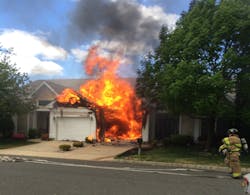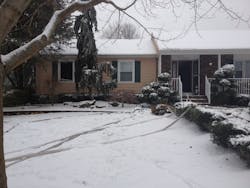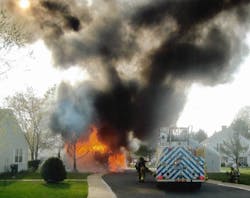Size-Up and the Initial Attack Hoseline
The success of the fire companies working at a building fire relies heavily on the actions of the first-arriving companies. More important than most considerations is the selection, deployment and application of the initial hoseline for fire attack. An efficient company that is well versed in deploying a handline can make quick work of most any fire encountered. However, many considerations have to be addressed when selecting the correct handline the first time.
The right line for the right fire
What’s burning? What is reported on size-up in relation to construction class, location and extent of fire and type of occupancy can dictate lines to be stretched per your department's policy (see Photo 1).
Rate of heat release (energy absorption): A crew must stretch the right hoseline that will absorb the amount of energy being released by the combustion process. While the pre-connect line may make the operation quicker, that does not guarantee that the operation will be a success (see Photo 2).There are some easy tips to calculate the right amount of hose. One method considers the number of floors in the building and the amount to get to the front door. This method is easily identified by stating “one to the door and one per floor," meaning at least one length for each level of a residential building, and a length from the apparatus to the door. So for consideration of a two-story residential building, less than 50 feet from the street, taking 150 feet of attack hose should make the top floor stretch successful. Another method calculates the size of the building and adds one length to the total amount needed. For example, if the above scenario defined the building as 50 feet long and 30 feet deep, the calculation of hose needed would be 50 + 30 + 50 (one length) at 130 feet. Rounding up would put the needed length at 150 feet of hose.
In some cases, buildings feature courtyard settings or long driveways that may require a larger supply line to be stretched for the attack lines to be attached to, in order to compensate for the loss of water pressure due to the long stretch (see Photo 4). Does your company practice these skills in the areas they protect? Are your apparatus set up with your hosebeds that can support this type of stretch?
Apparatus, personnel and equipment: What is coming on the initial alarm? Many stories about large fires start off as responding to simple fire alarm activations only to be caught short handed on arrival, forcing companies to play catch up. While the correct apparatus is vital to success, so are the right personnel, which are competent, capable, and correct in numbers for the tasks to be completed (see Photo 5). Getting the first line in service requires two to three firefighters to make the stretch, one to connect to the hydrant, one to operate the pump, and one officer to report conditions inside.
Ground level, above- and below-grade fires
All too often, we bear witness to well-meaning engine companies that show up to an alarm, deploy a handline of 150–200 feet, and find all of the company members located within 15–20 feet of the nozzle. While most companies stretch a handline into place with the nozzle at the point of access, and pull with all of their might to drag the hose and water into the structure, I submit to you an additional consideration. The nozzle firefighter should take the nozzle and the first coupling behind the nozzle up to the point of access. The point of access will vary, depending on the location of the fire. For example, a fire that is at grade level in the structure would best be served with the coupling at the grade level access point, such as the front door. In the event that the attack crew has to go up or down a flight of stairs to make the attack, that first coupling should be at the stairway access point, which is usually at the top of the stairs, to facilitate an easier (and faster) stretch through the stairs (see Photo 6). The crew should not spend any time on the stairs as the energy from the fire travels up the stairway while the crew is trying to descend it. Bringing the coupling to the closest point of access will aid in getting the necessary handline in place much more efficiently.
Consider the hose needed for a residential high-rise fire. Most of those structures have a common hallway with an entry door for each unit. If the crew stretched the handline with only the nozzle at the entry door, the crew will have to work in the common hallway, with the entry door open from the involved unit, releasing energy into the hallway where the crews are working to stretch the handline into position. If the coupling was stretched to the entry door along with the nozzle, the first length should be sufficient enough to reach all areas of the involved unit with little effort beyond the initial stretch.
Residential vs. commercial
Differences in the occupancies will dictate different considerations for handline selection and deployment. Many departments have policies that define a larger handline (2½-inch) for a commercial occupancy fire. The purpose behind this is related to the additional heat release rate (HRR) that can be present in commercial occupancies. To which I submit this for your consideration: the average home size while I was growing up varied between 800 and 1,000 square feet, were mostly stick built, and were limited in space, therefore limiting the potential HRR. Today’s homes can be found at 3,500-4,000 square feet, made of lightweight construction members, and include fuel packages that can easily overwhelm the capacity of smaller initial handlines. The wise officer who determines the correct handline must consider the potential HRR based on the building size, not so much the occupancy usage. Hydrocarbon based furnishings, coupled with larger amounts of air transfer within the structure, and possible hoarding conditions that could be present, may in fact dictate a larger line for a residential occupancy, should the necessity arise (See Photo 7). Always consider the potential for aggressive fire behavior when selecting the initial attack line.
Special considerations
It is suggested to practice "tactical patience,” where you take a breath and take the time to confirm the best location to access the fire, which might suggest a larger handline, or even a combination of supply lines and handlines in unison to resemble a courtyard lay.
Conclusion
Initial-arriving companies will set the stage for the overall success of the incident. Selecting the correct attack line early in the operation is vital to ensure the highest level of success. This decision is more than just a decision of convenience; considerations must include potential heat release rate, structural integrity, fuel loading and type of fuels present in the compartment, and accessibility to the compartment for suppression. Take the time to consider all components of the situation before committing to a suppression method that may not be efficient.
Until next time, stay focused and stay safe.



